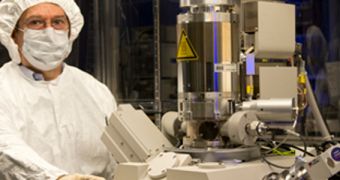Scientists with the Physical Measurement Laboratory at the US National Institutes of Standards and Technology (NIST) announce the development of a new method for characterizing the size and 3D shape of nanostructures as small as 10 nanometers across. The work provides unprecedented levels of accuracy, and could contribute to advancing the field of nanotechnology considerably.
The new approach characterizes structures by comparing data collected with a scanning electron microscope (SEM) with information stored in massive libraries of 3D shapes. This model-based method then quickly determines the most likely shape for the sample it studies.
Figuring out the exact shapes of nanostructures is extremely important for the manufacturing of integrated circuits (IC) and nanoscale features, such as those used to produce metamaterials. The latter are currently being investigated as the potential building blocks for invisibility and acoustic cloaks.
For years, SEM has remained the most sought-for imaging technique when it came to studying nanoscale features. One of the most important reasons for this high degree of popularity is that SEM can produce images at a resolution of just 1 nanometer. The drawback here is that these photos reveal the target structures only in 2D. This is where the new approach comes in.
The PML team says that these photographs in fact contain a high amount of detail that is lost when viewing them in 2D. By comparing the images with large-scale databases on similar structures, the group hopes to be able to extract as much of that extra data as possible. The study was led by expert András E. Vladár, who is based at the PML Semiconductor and Dimensional Metrology Division.
“There is no single method in the world that can give you all the answers. But, when two or three methods give you the same measurement result, your confidence in that result is much higher,” says the team leader. “We have developed a method that, in its current form, can be used by pretty much anyone who has a suitable scanning electron microscope,” he adds.
The team now plans to extend the capabilities of the new imaging system even further. This can be achieved by improving the resolution of nanoscale imaging, and by allowing the entire system access to larger, more complex databases of nanostructure shapes.
“We have high hopes that this method will work well in the 5 to 7 nm realm. We already have ideas on how we can push the technique further. This 3D technique is expected to impact a wide variety of technologies, ranging from integrated circuit production to nanotechnology for 3D characterization of nanostructures and nanoparticles, critical for catalytic and nanobio applications,” Vladár concludes.

 14 DAY TRIAL //
14 DAY TRIAL //